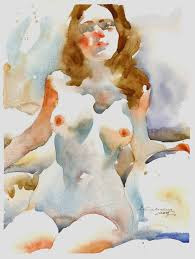Here are a couple of images that can get you started seeing the figure as a sequence of layers.
Try painting the whole figure as a single color silhouette. See if you can get used to starting from the inside of the form and working toward the outside edge, instead of drawing the profile and then coloring it in. I know nobody's watching, so you could just draw an out line and fill it in, but really, try it the other way, at least a couple of times. Use your brush to make shapes rather than lines.
Make some of your silhouettes in a very pale wash. Remember the tendency we saw in the portraits to make the first layer too dark. Better to make it too light. Well, best to make it just right, but too light leaves plenty of room for the shadows to contrast sufficiently.
Next, paint the shadow shapes as a layer by itself. The idea is to get used to seeing it as a separate layer that you can hold in suspension while you focus on the lights.
Finally, put the two layers together, adding a few accent darks where they are needed (creases, hair, eyes,. etc.)
Remember, it is not necessary to have a flawless figure present right from the start. When you are applying the first layer, you still have 2 or 3 opportunities to clarify the edges and proportions. Putting in a background can be a powerful tool in this regard.
Please bring lots of paper to this next session. Cheap sketch paper will be fine, not too small, though. And a couple of sheets of good watercolor paper for the longer poses.













